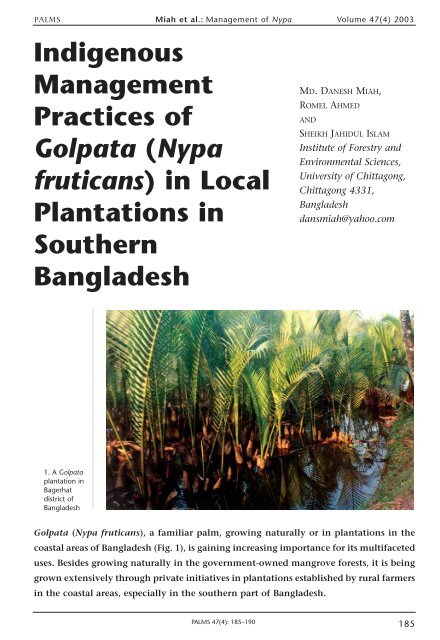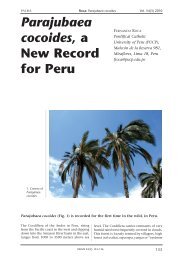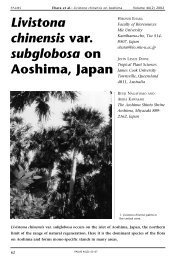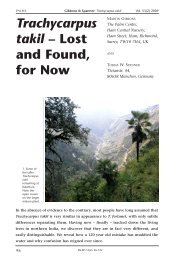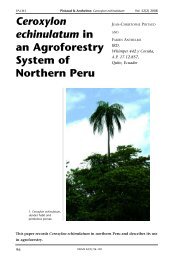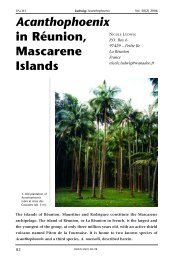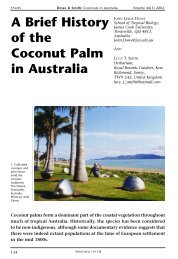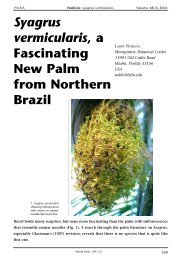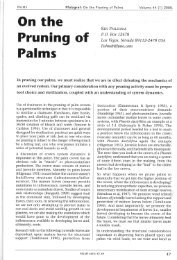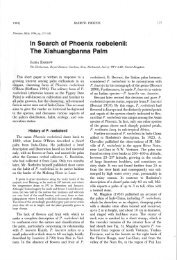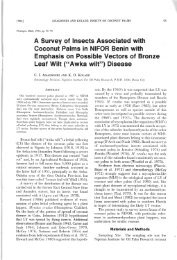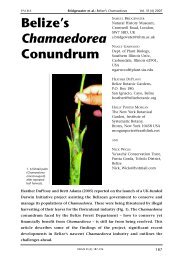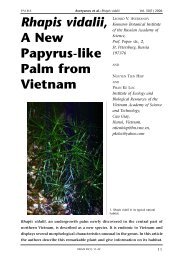Indigenous Management Practices of Golpata (Nypa fruticans) in ...
Indigenous Management Practices of Golpata (Nypa fruticans) in ...
Indigenous Management Practices of Golpata (Nypa fruticans) in ...
You also want an ePaper? Increase the reach of your titles
YUMPU automatically turns print PDFs into web optimized ePapers that Google loves.
PALMS Miah et al.: <strong>Management</strong> <strong>of</strong> <strong>Nypa</strong> Volume 47(4) 2003<br />
<strong>Indigenous</strong><br />
<strong>Management</strong><br />
<strong>Practices</strong> <strong>of</strong><br />
<strong>Golpata</strong> (<strong>Nypa</strong><br />
<strong>fruticans</strong>) <strong>in</strong> Local<br />
Plantations <strong>in</strong><br />
Southern<br />
Bangladesh<br />
MD. DANESH MIAH,<br />
ROMEL AHMED<br />
AND<br />
SHEIKH JAHIDUL ISLAM<br />
Institute <strong>of</strong> Forestry and<br />
Environmental Sciences,<br />
University <strong>of</strong> Chittagong,<br />
Chittagong 4331,<br />
Bangladesh<br />
dansmiah@yahoo.com<br />
1. A <strong>Golpata</strong><br />
plantation <strong>in</strong><br />
Bagerhat<br />
district <strong>of</strong><br />
Bangladesh<br />
<strong>Golpata</strong> (<strong>Nypa</strong> <strong>fruticans</strong>), a familiar palm, grow<strong>in</strong>g naturally or <strong>in</strong> plantations <strong>in</strong> the<br />
coastal areas <strong>of</strong> Bangladesh (Fig. 1), is ga<strong>in</strong><strong>in</strong>g <strong>in</strong>creas<strong>in</strong>g importance for its multifaceted<br />
uses. Besides grow<strong>in</strong>g naturally <strong>in</strong> the government-owned mangrove forests, it is be<strong>in</strong>g<br />
grown extensively through private <strong>in</strong>itiatives <strong>in</strong> plantations established by rural farmers<br />
<strong>in</strong> the coastal areas, especially <strong>in</strong> the southern part <strong>of</strong> Bangladesh.<br />
PALMS 47(4): 185–190<br />
185
PALMS Miah et al.: <strong>Management</strong> <strong>of</strong> <strong>Nypa</strong> Volume 47(4) 2003<br />
The mangrove palm, <strong>Nypa</strong> <strong>fruticans</strong> locally named<br />
as <strong>Golpata</strong> <strong>in</strong> Bengali, popularly known as the poor<br />
man’s t<strong>in</strong>-sheet, is one <strong>of</strong> the important nontimber<br />
forest products <strong>of</strong> the tidal estuaries <strong>in</strong> the<br />
coastal belt <strong>of</strong> Bangladesh (Das et al. 2000). It is a<br />
stemless palm with tall erect fronds and<br />
underground rhizomatous stem (Shahidullah<br />
2001) possess<strong>in</strong>g an extensive root system, well<br />
suited to resist swift runn<strong>in</strong>g water (Percival &<br />
Womersley 1975).<br />
The management <strong>of</strong> <strong>Nypa</strong> <strong>in</strong> local plantations is<br />
accomplished entirely through the use <strong>of</strong><br />
<strong>in</strong>digenous knowledge. <strong>Golpata</strong> is reported to be<br />
used ma<strong>in</strong>ly for hous<strong>in</strong>g, food, fuel, fence-mak<strong>in</strong>g,<br />
medic<strong>in</strong>e, cigarette wrapp<strong>in</strong>g, molasses, w<strong>in</strong>e,<br />
fish<strong>in</strong>g etc. The kernels <strong>of</strong> immature fruits are used<br />
as food. The juice is used for mak<strong>in</strong>g molasses,<br />
locally called Gur, and alcohol. Newly developed<br />
shoots are reported to be used as a vermicide. Ash<br />
from <strong>Golpata</strong> is used as an analgesic aga<strong>in</strong>st tooth<br />
pa<strong>in</strong> and headache. Dry leaves, petiole, stem<br />
wood, fruit residues etc. are used as fuel. In fish<strong>in</strong>g<br />
rhizomes <strong>of</strong> <strong>Golpata</strong> are extensively used,<br />
facilitat<strong>in</strong>g the fish<strong>in</strong>g net to float over the water<br />
surface. Farmers also report that <strong>Golpata</strong> <strong>in</strong> the<br />
river or sea attracts deep-water fish. Bomhard<br />
(1964) and Killmann et al. (1989) describe the<br />
various ways <strong>of</strong> us<strong>in</strong>g <strong>Golpata</strong> for hous<strong>in</strong>g and<br />
other important purposes. FAO (1995) and<br />
Hamilton and Murphy (1988) describe the tapp<strong>in</strong>g<br />
<strong>of</strong> the palm for beverages such as w<strong>in</strong>e or toddy<br />
and identify this as an ancient and traditional<br />
practice <strong>in</strong> Pan-Pacific and South and Southeast<br />
Asian countries. The present study discusses the<br />
<strong>in</strong>digenous knowledge <strong>of</strong> local farmers <strong>in</strong> the<br />
southern part <strong>of</strong> Bangladesh regard<strong>in</strong>g plant<strong>in</strong>g<br />
pattern, multiplication, development <strong>of</strong> new<br />
plantations, tend<strong>in</strong>g operation, harvest<strong>in</strong>g,<br />
process<strong>in</strong>g, market<strong>in</strong>g <strong>of</strong> <strong>Golpata</strong> and <strong>in</strong>come from<br />
it.<br />
In Bangladesh, the natural distribution <strong>of</strong> <strong>Golpata</strong><br />
is restricted to the Sundarbans, the largest s<strong>in</strong>gle<br />
cont<strong>in</strong>uous tract <strong>of</strong> mangrove forest <strong>in</strong> the world<br />
(Chaudhury & Naithani 1985, Akhtaruzzaman<br />
2000). Throughout the country, the demand for<br />
<strong>Golpata</strong> products is much higher than the present<br />
production. Shiva (1994) reports that <strong>Golpata</strong> has<br />
a great potential for commercial use <strong>in</strong> hous<strong>in</strong>g<br />
and medic<strong>in</strong>e <strong>in</strong> Bangladesh. The role <strong>of</strong> <strong>Golpata</strong><br />
is <strong>in</strong>valuable for both the rural and urban<br />
livelihood economies <strong>of</strong> Bangladesh. About 50,000<br />
people liv<strong>in</strong>g around the Sundarbans depend on<br />
<strong>Golpata</strong> and about 80% <strong>of</strong> houses <strong>in</strong> the area are<br />
made <strong>of</strong> <strong>Golpata</strong> (Faizudd<strong>in</strong> et al. 2000a). Although<br />
many local people around the Sundarbans plant<br />
<strong>Golpata</strong> on their available land, the <strong>in</strong>creased<br />
demand for hous<strong>in</strong>g and other uses can only be<br />
fulfilled by <strong>in</strong>creas<strong>in</strong>g production through<br />
plantation establishment and susta<strong>in</strong>able management<br />
<strong>of</strong> the wild resource.<br />
The study site<br />
The study area <strong>of</strong> Bagerhat falls under the old<br />
Ganges meander flood pla<strong>in</strong> zone cover<strong>in</strong>g the<br />
gray silty acid sulfate clay (BBS 1988). The pH <strong>of</strong><br />
the soil ranges from 7.5 to 8.0 (Faizudd<strong>in</strong> et al.<br />
2000b). The district has a hot summer and a mild<br />
w<strong>in</strong>ter. The summer beg<strong>in</strong>s from the middle <strong>of</strong><br />
April and cont<strong>in</strong>ues till the middle <strong>of</strong> June. The<br />
w<strong>in</strong>ter starts from November and cont<strong>in</strong>ues till<br />
February. The maximum and m<strong>in</strong>imum mean<br />
temperature dur<strong>in</strong>g the summer is 35.6ºC and<br />
24.6ºC, respectively. The maximum and m<strong>in</strong>imum<br />
mean temperature dur<strong>in</strong>g the w<strong>in</strong>ter is 27.2ºC and<br />
14.6ºC, respectively. The level <strong>of</strong> humidity rises<br />
above 95% <strong>in</strong> the monsoon that commences from<br />
the middle <strong>of</strong> June and cont<strong>in</strong>ues till the end <strong>of</strong><br />
September (BBS 1988). The range <strong>of</strong> annual ra<strong>in</strong>fall<br />
recorded <strong>in</strong> the district is 1640–2000 mm (Siddiqi<br />
2001). Topographical, geological and climatological<br />
conditions together make the district prone<br />
to severe cyclone occurr<strong>in</strong>g <strong>in</strong> the early part <strong>of</strong><br />
the summer and the later part <strong>of</strong> the monsoon. But<br />
the district is not seriously affected by these due<br />
to the locations <strong>of</strong> Sundarbans <strong>in</strong> the south part<br />
<strong>of</strong> the districts that acts as a shelter-belt (BBS 1999).<br />
Materials and Methods<br />
The study was conducted <strong>in</strong> the district <strong>of</strong><br />
Bagerhat, <strong>in</strong> the southern part <strong>of</strong> Bangladesh, for<br />
a three-month period between January to March<br />
2002. <strong>Golpata</strong> is commonly planted surround<strong>in</strong>g<br />
the homesteads <strong>of</strong> Bagerhat with<strong>in</strong> the tidal<br />
coastl<strong>in</strong>e.<br />
The study was conducted by <strong>in</strong>terview<strong>in</strong>g 40 rural<br />
household-members and visit<strong>in</strong>g the <strong>Golpata</strong><br />
plantation directly. Data were collected from male<br />
heads or other important respondents through a<br />
semi-structured questionnaire. The distribution <strong>of</strong><br />
<strong>Golpata</strong> plantations <strong>in</strong> the study area was directly<br />
observed. The <strong>in</strong>formation on multiplication,<br />
development <strong>of</strong> new plantations, tend<strong>in</strong>g<br />
operations, harvest<strong>in</strong>g, process<strong>in</strong>g, market<strong>in</strong>g and<br />
uses <strong>of</strong> <strong>Golpata</strong> were gathered.<br />
The data were collected from four villages, two<br />
each from the Upazilla (sub-district), namely<br />
Bagerhat Sadar and Sarankhola where <strong>Golpata</strong><br />
plantation is a common forestry practice. The<br />
name <strong>of</strong> the villages sampled from Bagerhat Sadar<br />
were Saidayllapur and Sayera and from Sarankhola<br />
were Rayenda and Soudhkhali.<br />
As nurs<strong>in</strong>g and production <strong>of</strong> <strong>Golpata</strong> plantation<br />
are the functions <strong>of</strong> the land-hold<strong>in</strong>g capacity <strong>of</strong><br />
186
PALMS Miah et al.: <strong>Management</strong> <strong>of</strong> <strong>Nypa</strong> Volume 47(4) 2003<br />
Table 1: Distribution <strong>of</strong> <strong>Golpata</strong> (<strong>Nypa</strong> <strong>fruticans</strong>) plantations <strong>in</strong> different sites <strong>in</strong> the Bagerhat<br />
district <strong>of</strong> Bangladesh.<br />
Plantation sites<br />
(No. <strong>of</strong> plantations)<br />
Total<br />
Homestead Borrow pits Ditch site Lower pla<strong>in</strong>s<br />
<strong>of</strong> agricultural<br />
Household category<br />
lands<br />
Landless 5 2 4 7 18<br />
Marg<strong>in</strong>al 7 9 11 6 33<br />
Small 7 3 4 10 24<br />
Medium 2 1 1 4 8<br />
Large 2 0 2 3 7<br />
Total 23 15 22 30 90<br />
Table 2: Production <strong>of</strong> sap from different aged <strong>Golpata</strong> <strong>in</strong> the plantations <strong>of</strong> Bagerhat district <strong>of</strong><br />
Bangladesh.<br />
Age class<br />
Sap production (ml/shoot/season)<br />
0–4 0<br />
5–8 800–1000<br />
9–12 1500–1900<br />
13–15 1000–1200<br />
>15 600–700<br />
the households, the farmers were stratified <strong>in</strong>to<br />
marg<strong>in</strong>al (0.21–0.50 ha), small (0.51–1.00 ha),<br />
medium (1.01–2.00 ha) and large (above 2.00 ha)<br />
landowners. Out <strong>of</strong> this stratification, 40<br />
households, 10 households from each village,<br />
randomly represent<strong>in</strong>g each stratum, were<br />
selected.<br />
Results and discussion<br />
Distribution <strong>of</strong> <strong>Golpata</strong> plantations <strong>in</strong> the landscape<br />
With<strong>in</strong> the landscape <strong>of</strong> the study area, four<br />
different sites under <strong>Golpata</strong> cultivation were<br />
identified. These were homesteads, “borrow pits”,<br />
ditch sites and the lower pla<strong>in</strong>s <strong>of</strong> agricultural land<br />
(borrow pits are the pits left after soil is extracted<br />
for road build<strong>in</strong>g or embankment construction;<br />
they fill up with sal<strong>in</strong>e water and are thus suitable<br />
for golpata cultivation). The study revealed that<br />
highest number <strong>of</strong> farms (n = 30) were found <strong>in</strong><br />
the lower pla<strong>in</strong> <strong>of</strong> agricultural land followed by<br />
homesteads (n = 23), whereas, the lowest number<br />
(n = 15) were found along the borrow pits (Table<br />
1). However, the variation <strong>in</strong> the number <strong>of</strong> farms<br />
among different household categories was easily<br />
observed <strong>in</strong> the study area. All farmers suggested<br />
that the production <strong>of</strong> <strong>Golpata</strong> was higher <strong>in</strong> lower<br />
pla<strong>in</strong> lands where <strong>in</strong>undation was common and<br />
lowest <strong>in</strong> homesteads, where, <strong>of</strong> course,<br />
<strong>in</strong>undation is not frequent. This was due to<br />
variation <strong>of</strong> sal<strong>in</strong>ity and tidal <strong>in</strong>undation. This<br />
was also supported by Aksornkoae (1987) and<br />
Untawale (1987) who reported that sal<strong>in</strong>ity and<br />
tidal <strong>in</strong>undation are considered as important<br />
requirements for the occurrence <strong>of</strong> <strong>Golpata</strong>.<br />
The number <strong>of</strong> plantations was highest <strong>in</strong> the<br />
marg<strong>in</strong>al category <strong>of</strong> the farmers (n = 33) followed<br />
by small (n = 24), landless (n = 18), medium (n =<br />
8) and large (n = 7) as shown <strong>in</strong> Table 1.<br />
Multiplication with<strong>in</strong> the plantations<br />
The exist<strong>in</strong>g plantations were reported to be<br />
multiplied through rhizome, viviparous<br />
germ<strong>in</strong>ation and separation <strong>of</strong> lead<strong>in</strong>g shoots.<br />
About five to six percent <strong>of</strong> clumps produced two<br />
lead<strong>in</strong>g shoots at a time per year <strong>in</strong>stead <strong>of</strong> one<br />
lead<strong>in</strong>g shoot. Those two shoots gradually<br />
separated from each other at right and left side,<br />
respectively and ultimately produced two clumps.<br />
This was observed at the periphery <strong>of</strong> the farm.<br />
Development <strong>of</strong> new plantations<br />
S<strong>of</strong>t, muddy and water-logged soils where free<br />
access <strong>of</strong> sal<strong>in</strong>e water was available were<br />
characteristic <strong>of</strong> the land used by farmers <strong>in</strong><br />
select<strong>in</strong>g sites for <strong>Golpata</strong> plantations. Seed and<br />
seedl<strong>in</strong>gs, as well as developed seedl<strong>in</strong>gs from the<br />
viviparous germ<strong>in</strong>ation were the ma<strong>in</strong> plant<strong>in</strong>g<br />
material. Four different sources <strong>of</strong> these plant<strong>in</strong>g<br />
materials were identified and these were float<strong>in</strong>g<br />
seeds from water bodies (65%), own material<br />
(30%), from neighbors (3%) and from the market<br />
(2%). The one-year-old seedl<strong>in</strong>gs were generally<br />
planted dur<strong>in</strong>g the ra<strong>in</strong>y season at a spac<strong>in</strong>g <strong>of</strong><br />
1.82 × 1.82 m. Farmers reported that if stagnant<br />
water conditions lasted 5 or 6 weeks immediately<br />
after plant<strong>in</strong>g, with the seedl<strong>in</strong>gs consequently<br />
fully under water, the seedl<strong>in</strong>gs would then<br />
become rotten. To encourage the establishment<br />
187
PALMS Miah et al.: <strong>Management</strong> <strong>of</strong> <strong>Nypa</strong> Volume 47(4) 2003<br />
Table 3: Farm size and <strong>in</strong>come <strong>of</strong> the <strong>Golpata</strong> planters <strong>in</strong> Bagerhat district <strong>of</strong> Bangladesh.<br />
Farm category Average farm Frequency Av. number Income/ Change <strong>in</strong><br />
size (ha) <strong>of</strong> leaves year (Tk**) <strong>in</strong>come (%)<br />
harvested/yr<br />
(Pon*)<br />
Landless 0.14 18 22 4667 -<br />
Small 0.3 43 62 12463 16.7<br />
Marg<strong>in</strong>al 0.46 24 91 18833 51<br />
Medium 0.71 8 129 23220 23.1<br />
Large 0.76 7 142 26373 13.57<br />
*1 Pon equals 80 leaves.<br />
** 1 US $ = 58 Tk<br />
<strong>of</strong> the seedl<strong>in</strong>gs, at least 10–12 cm <strong>of</strong> the seedl<strong>in</strong>gs<br />
should rema<strong>in</strong> above the water level.<br />
Tend<strong>in</strong>g operation<br />
It was reported that the farmers practiced weed<strong>in</strong>g,<br />
th<strong>in</strong>n<strong>in</strong>g, removal <strong>of</strong> diseased or unexpanded<br />
leaflets, gap fill<strong>in</strong>g at 100%, 65%, 35% and 28%,<br />
respectively. Faizudd<strong>in</strong> et al. (2000b) and Siddiqi<br />
(1999) also po<strong>in</strong>ted out such ma<strong>in</strong>tenance<br />
operations for the acceleration <strong>of</strong> <strong>Golpata</strong><br />
production <strong>in</strong> Bangladesh. Gonzales (1979)<br />
suggested th<strong>in</strong>n<strong>in</strong>g <strong>in</strong> order to ma<strong>in</strong>ta<strong>in</strong> desired<br />
density and Siddiqi (1999) recommended prun<strong>in</strong>g<br />
<strong>of</strong> non-leafy leaflet <strong>of</strong> <strong>Golpata</strong> for the acceleration<br />
<strong>of</strong> production.<br />
Harvest<strong>in</strong>g<br />
All <strong>of</strong> the farmers surveyed, irrespective <strong>of</strong><br />
household category, suggested that the extraction<br />
<strong>of</strong> leaves normally started from the 6- or 7-year old<br />
plants with<strong>in</strong> the plantation. A slant<strong>in</strong>g cut,<br />
ma<strong>in</strong>ta<strong>in</strong><strong>in</strong>g a 45º angle is used. The cutt<strong>in</strong>g height<br />
above the ground depends on the plant<strong>in</strong>g density.<br />
Accord<strong>in</strong>g to the farmers, if the density is high,<br />
cutt<strong>in</strong>g is undertaken at 7 or 8 cm above the<br />
ground and <strong>in</strong> case <strong>of</strong> low density, at 5 or 6 cm.<br />
The season <strong>of</strong> harvest<strong>in</strong>g was January to February<br />
as new shoot development beg<strong>in</strong>s <strong>in</strong> March. The<br />
reason beh<strong>in</strong>d the harvest<strong>in</strong>g season practiced is<br />
to allow access to the new leaves for the next<br />
month.<br />
<strong>Golpata</strong> is also much valued for the sweet sap<br />
tapped from the stalk <strong>of</strong> the <strong>in</strong>florescence. It was<br />
reported that tapp<strong>in</strong>g normally commences from<br />
the <strong>Golpata</strong> shoots after four years and cont<strong>in</strong>ues<br />
up to 15 years or more. The shoots <strong>of</strong> 9–12 year<br />
old stems are reported to be the highest yield<strong>in</strong>g,<br />
provid<strong>in</strong>g up to 1500–1900 ml <strong>of</strong> sap per stem per<br />
season. The stems <strong>of</strong> 15 years or more were<br />
reported to yield a reduced sap production (Table<br />
2). The farmers also reported that palms from<br />
canals, ditches or riversides gave the highest<br />
amount <strong>of</strong> sap. Tapp<strong>in</strong>g began from the first week<br />
<strong>of</strong> December when the fruit beg<strong>in</strong>s to mature and<br />
turns tan. The stalk <strong>of</strong> <strong>in</strong>florescence was then<br />
pulled down and every morn<strong>in</strong>g and even<strong>in</strong>g, a<br />
th<strong>in</strong> slice <strong>of</strong> stalk was removed and sap collected<br />
2. A stack <strong>of</strong> <strong>Golpata</strong> leaves <strong>in</strong> Bagerhat district <strong>of</strong> Bangladesh.<br />
188
PALMS Miah et al.: <strong>Management</strong> <strong>of</strong> <strong>Nypa</strong> Volume 47(4) 2003<br />
<strong>in</strong> a conta<strong>in</strong>er called a Got. This was cont<strong>in</strong>ued up<br />
to the next mid March. It was also reported that<br />
1 kg molasses was produced from 7–8 liters <strong>of</strong> sap.<br />
Most <strong>of</strong> the farmers surveyed were reluctant to<br />
tap the stems because <strong>of</strong> the decl<strong>in</strong>e <strong>in</strong> the quality<br />
<strong>of</strong> leaf production. However, it was observed that<br />
10% <strong>of</strong> the landless farmers tapped the stems for<br />
w<strong>in</strong>e.<br />
Process<strong>in</strong>g<br />
The harvested leaflets are reported to be cut at 5<br />
or 6 cm above the bottom <strong>of</strong> the rachis. Then,<br />
eight leaflets are arranged one after another<br />
keep<strong>in</strong>g the apex at one direction. The rachis <strong>of</strong><br />
accumulated leaflets is then divided <strong>in</strong>to two parts<br />
by pull<strong>in</strong>g them <strong>in</strong> opposite direction. Generally,<br />
the operation is undertaken manually (two men)<br />
immediately after harvest<strong>in</strong>g. Each <strong>of</strong> the<br />
separated portions was called dhali. F<strong>in</strong>ally,<br />
arrang<strong>in</strong>g right and left dhalis separately, expos<strong>in</strong>g<br />
the rachis <strong>in</strong> a southerly direction for accelerated<br />
rapid dry<strong>in</strong>g, heaps 0.91–0.95 m high are made.<br />
Each side <strong>of</strong> the heap was fixed by driv<strong>in</strong>g two<br />
stakes 2.74 m apart and a weight was provided at<br />
the top <strong>of</strong> the heap to make them compact,<br />
prevent<strong>in</strong>g free air circulation as it promotes the<br />
deformation <strong>of</strong> the leaflets. After 15 days <strong>in</strong> the<br />
heap, the leaflets turned tan <strong>in</strong> color. Generally<br />
they were kept 20–25 days <strong>in</strong> each heap. A stack<br />
<strong>of</strong> <strong>Golpata</strong> leaves is shown <strong>in</strong> the Fig. 2.<br />
Market<strong>in</strong>g<br />
The processed leaves are reported to be the<br />
pr<strong>in</strong>cipal product for market<strong>in</strong>g. Every three to<br />
four years, the growers themselves consume a<br />
negligible portion <strong>of</strong> the products for hous<strong>in</strong>g<br />
purposes and the rema<strong>in</strong>der are sold. Several<br />
<strong>in</strong>termediaries, operat<strong>in</strong>g <strong>in</strong> between the growers<br />
and the end users, acted <strong>in</strong> the market<strong>in</strong>g <strong>of</strong> leaves.<br />
Generally, the leaves moved from growers through<br />
middlemen to wholesalers, to retailers and f<strong>in</strong>ally<br />
to the end users (Fig. 3). In some cases, the<br />
middlemen sell dried leaves to the retailers or<br />
directly to the consumers. However, some retailers<br />
had another pr<strong>of</strong>itable mechanism to bypass the<br />
wholesalers or middlemen, directly buy<strong>in</strong>g leaves<br />
from the growers. Another important product<br />
reported to be sold is Gur (molasses), which<br />
generally followed a short market<strong>in</strong>g cha<strong>in</strong>; this<br />
product is sold directly to the end-users <strong>in</strong> villages<br />
or <strong>in</strong> local markets.<br />
Farm size and <strong>in</strong>come<br />
The study revealed that <strong>Golpata</strong> farm sizes ranged<br />
from 0.14 ha to 0.76 ha, gradually <strong>in</strong>creas<strong>in</strong>g with<br />
the <strong>in</strong>crease <strong>of</strong> land hold<strong>in</strong>gs. The highest number<br />
<strong>of</strong> farms (n = 43) <strong>of</strong> average size 0.3 ha was<br />
observed <strong>in</strong> small category followed by the<br />
marg<strong>in</strong>al category (n = 24) <strong>of</strong> average size 0.46 ha<br />
(Table 3). The highest <strong>in</strong>come (Tk 26373 = approx.<br />
US$450) was earned by large farmers and the<br />
lowest (Tk 4667 = approx US$80) by landless<br />
farmer (Table 3). The variation <strong>in</strong> <strong>in</strong>come among<br />
the farmers occurred due to the size <strong>of</strong> farms and<br />
the pattern <strong>of</strong> their own consumption. It was<br />
reported that their own consumption <strong>of</strong> <strong>Golpata</strong><br />
products by the large farm categories was<br />
comparatively higher than the small farm<br />
categories. Due to the variation <strong>of</strong> the farm size,<br />
leaf production and sale are varied, which is also<br />
reflected <strong>in</strong> the variation <strong>in</strong> <strong>in</strong>come <strong>of</strong> the different<br />
farm categories.<br />
Conclusions<br />
<strong>Golpata</strong> is an important natural resource and the<br />
only palm species used for hous<strong>in</strong>g <strong>in</strong> the southern<br />
part <strong>of</strong> Bangladesh. It plays an active role <strong>in</strong> the<br />
contribution to rural livelihoods and to the<br />
cultural heritage <strong>of</strong> the people. Besides solv<strong>in</strong>g the<br />
hous<strong>in</strong>g problem, it also helps to alleviate poverty<br />
<strong>in</strong> the region by provid<strong>in</strong>g many people access to<br />
the cash economy. The government and NGOs<br />
should extend their help<strong>in</strong>g hand provid<strong>in</strong>g<br />
appropriate technology for cultivation,<br />
End user<br />
Whole seller<br />
3. Market<strong>in</strong>g<br />
channel <strong>of</strong><br />
<strong>Golpata</strong><br />
products <strong>in</strong><br />
Bagerhat district<br />
<strong>of</strong> Bangladesh.<br />
Retailer<br />
Middleman<br />
Grower<br />
189
PALMS Miah et al.: <strong>Management</strong> <strong>of</strong> <strong>Nypa</strong> Volume 47(4) 2003<br />
management, process<strong>in</strong>g, market<strong>in</strong>g and<br />
utilization <strong>in</strong>corporat<strong>in</strong>g the traditional<br />
knowledge described <strong>in</strong> this paper. Bangladesh has<br />
available newly raised coastal lands along the<br />
coastal belt and vacant areas <strong>in</strong> the Sundarbans<br />
suitable for <strong>Golpata</strong> plantation (Faizudd<strong>in</strong> et al.<br />
1998, Siddiqi & Khan 1990) where <strong>Golpata</strong><br />
plantation can be raised, <strong>in</strong>volv<strong>in</strong>g local people<br />
who already have knowledge <strong>of</strong> <strong>Golpata</strong><br />
cultivation.<br />
LITERATURE CITED<br />
AKHTARUZZAMAN, A.F.M. 2000. Mangrove forestry<br />
research <strong>in</strong> Bangladesh. In: Asia-Pacific<br />
Cooperation on Research for Conservation <strong>of</strong><br />
Mangroves, Proceed<strong>in</strong>gs <strong>of</strong> an International<br />
Workshop, 26–30 March, 2000, Ok<strong>in</strong>awa, Japan.<br />
pp. 139–146.<br />
AKSORNKOAE, S. 1987. Country report: Thailand.<br />
In: UMALI, R.M. (ed.). Mangroves <strong>of</strong> Asia and the<br />
Pacific: Status and <strong>Management</strong>. UNDP/<br />
UNESCO (RAS/79/002), Philipp<strong>in</strong>es. pp.<br />
231–262.<br />
BBS (BANGLADESH BUREAU OF STATISTICS). 1988. The<br />
Bangladesh Census <strong>of</strong> Agriculture and livestock:<br />
1983–84. M<strong>in</strong>istry <strong>of</strong> Plann<strong>in</strong>g, Dhaka,<br />
Bangladesh. 108 pp.<br />
BBS. 1999. Statistical Yearbook <strong>of</strong> Bangladesh.<br />
M<strong>in</strong>istry <strong>of</strong> Plann<strong>in</strong>g, Dhaka, Bangladesh. 652<br />
pp.<br />
BOMHARD, M.L. 1964. Palms – their use <strong>in</strong> build<strong>in</strong>g.<br />
Leaflet no. 2. Hous<strong>in</strong>g and Home F<strong>in</strong>ance<br />
Agency <strong>of</strong>fice <strong>of</strong> International Hous<strong>in</strong>g,<br />
Wash<strong>in</strong>gton, D.C.<br />
CHAUDHURI, A.B. AND H.B. NAITHANI. 1985. A<br />
comprehensive Survey <strong>of</strong> Tropical Mangrove<br />
Forests <strong>of</strong> Sundarbans and Andamans. Part I.<br />
International Book Distributors, Dehra Dun,<br />
India. 41 pp.<br />
DAS, S.C., S. AKHTER, A.K.M. WAZIHULLAH AND M.S<br />
RAHMAN. 2000.Yield <strong>of</strong> V<strong>in</strong>egar, Alcohol and<br />
Sugar from the Sap <strong>of</strong> <strong>Nypa</strong> <strong>fruticans</strong>. Bangladesh<br />
J. Forest Sc. 29: 92–96.<br />
FAO, 1995. Integrated Resource Development <strong>of</strong><br />
the Sunderbans Reserved Forest, Bangladesh.<br />
Draft f<strong>in</strong>al report. FAO: DP/BGD/84/056.<br />
FAIZUDDIN, M., M.M. RAHMAN, M. SHAHIDULLAH,<br />
H.U.A. SIDDIQUI, M. HASNIN AND M.H. RASHID.<br />
1998. Plantation <strong>of</strong> <strong>Golpata</strong> (<strong>Nypa</strong> <strong>fruticans</strong>) <strong>in</strong><br />
the newly accreted sites <strong>of</strong> the Sundarbans<br />
mangrove forests <strong>of</strong> Bangladesh. Paper accepted<br />
for presentation <strong>in</strong> the “Tropical Restoration for<br />
the New Millennium Conference”, Sun Juan,<br />
Puerto Rico, USA, May 23–24,1999.<br />
FAIZUDDIN, M., M.M. RAHMAN, M. SHAHIDULLAH,<br />
A.S.M. HELALSIDDIQUI, M. HASNIN AND M.H. RASHID.<br />
2000a. <strong>Golpata</strong> (<strong>Nypa</strong> <strong>fruticans</strong>)-an important<br />
forest produce <strong>of</strong> the Sundarbans. Mangrove<br />
silviculture division, Bangladesh Forest Research<br />
Institute (BFRI), Khulna, Bangladesh.<br />
FAIZUDDIN, M., M.M. RAHMAN, M. SHAHIDULLAH,<br />
A.S.M. HELALSIDDIQUI, M. HASNIN AND M.H.<br />
RASHID. 2000b. Survival and growth performance<br />
<strong>of</strong> <strong>Golpata</strong> (<strong>Nypa</strong> <strong>fruticans</strong>) <strong>in</strong> the newly accreted<br />
sites <strong>of</strong> the Sundarbans <strong>of</strong> Bangladesh.<br />
Bangladesh Journal <strong>of</strong> Forest Science 29: 79–84.<br />
GONZALES, L.L. 1979. Nipa and its <strong>in</strong>numerable<br />
uses. Canopy 5(5): 9.<br />
HAMILTON, L.S. AND D.H. MURPHY. 1988. Use and<br />
<strong>Management</strong> <strong>of</strong> Nipa palm. Econ. Bot. 42:<br />
206–213.<br />
KILLMANN, W., W.C. WONG AND K. SHAARI. 1989.<br />
Utilization <strong>of</strong> Palm stems and leaves: an<br />
annotated bibliography. Forest Research<br />
Institute, Kuala Lumpur, Malaysia.<br />
PERCIVAL, M. AND J.S. WOMERSLEY. 1975. Floristics<br />
and Ecology <strong>of</strong> the Mangrove Vegetation <strong>of</strong><br />
Papua New Gu<strong>in</strong>ea. Botany Bullet<strong>in</strong> No. 8,<br />
Department <strong>of</strong> Forests, Papua New Gu<strong>in</strong>ea. 94<br />
pp.<br />
SHAHIDULLAH, M. 2001. Nursery and Plantation<br />
Techniques <strong>of</strong> <strong>Golpata</strong> (<strong>Nypa</strong> <strong>fruticans</strong>). In:<br />
SIDDIQUI, N.A. AND M.W. BAKSHA (eds.),<br />
Proceed<strong>in</strong>gs <strong>of</strong> the National Workshop on<br />
Mangrove Research and Development at<br />
Bangladesh Forest Research Institute,<br />
Chittagong, Bangladesh 15-16 May, 2001.<br />
pp.33–38.<br />
SHIVA, M.P. 1994. Report on Mangrove Non-wood<br />
Forest Products. FAO/UNDP project<br />
BGD/84/056, Khulna, Bangladesh. 147 pp.<br />
SIDDIQI, N.A. 1999. Rais<strong>in</strong>g plantation <strong>of</strong> nipa palm<br />
on new accretions along the coastl<strong>in</strong>e <strong>of</strong><br />
Bangladesh. J. Non-timber For. Prod. 6: 52–56.<br />
SIDDIQI, N.A. 2001. Mangrove forestry <strong>in</strong><br />
Bangladesh. Institute <strong>of</strong> Forestry and<br />
Environmental Sciences, University <strong>of</strong><br />
Chittagong, 201 pp.<br />
SIDDIQI, N.A. AND M.A.S. KHAN. 1990. The growth<br />
performance <strong>of</strong> mangrove trees along the coastal<br />
belt <strong>of</strong> Bangladesh. Mangrove Ecosystem<br />
Occasional Papers, No. 8. pp. 4–14.<br />
UNTAWALE, A.G. 1987. Country report: India. In:<br />
UMALI, R.M. (ed.). Mangroves <strong>of</strong> Asia and the<br />
Pacific: Status and <strong>Management</strong>. UNDP/<br />
UNESCO (RAS/79/002), Philipp<strong>in</strong>es. pp.81–87.<br />
190


